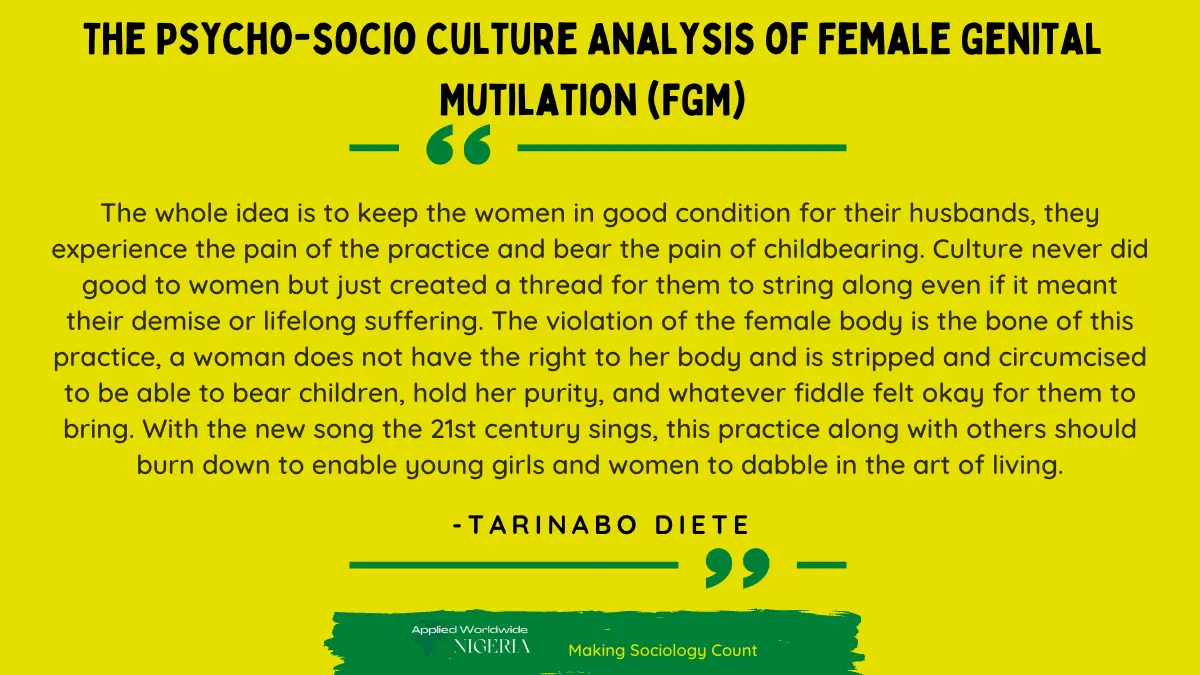FGM in full stands for Female Genital Mutilation and it is a practice that comprises all procedures that involve partial or total removal of the external female genitalia or other injuries to the female genital organ for non-medical reasons. Girls between the ages of 6-12, some at birth and some prior to marriage. FGM is recognized worldwide as a violation of the human rights of girls and women. It is commonly known as “female circumcision,’’ it is a ritual of cutting or removal or some part of the external female genitalia. The practice is found in African, Asia, and Middle Eastern countries.

Types of Female Genital Mutilation
FGM is classified into three major types from the data collected the three types depend on the reason the practice is conducted.
TYPE 1 is called Clitoridectomy/clitorectomy is the surgical removal, reduction, or partial removal of the glans (the external and visible part of the, which is the most sensitive part of the female genital organ and the labia minora (the inner folds of the vulva ) with or without the removal of the labia majora (the outer folds of the skin of the vulva).
2 TYPE 2 is called infibulation, the ritual removal of the external female genitalia and the suturing of the vulva. This is the narrowing of the vaginal opening through the creation of a covering seal.
TYPE 3 is called excision, this is the complete or partial removal of the inner labia, with or without the removal of the glans and outer labia. Excision has three (3) types which are the type lla, type llb, and type llc. The TYPE LLA is the total removal of the inner labia, TYPE LLB is the removal of the clitoral glans and inner labia and TYPE LLC is the removal of the clitoral glans, and inner and outer labia.
What is the reason behind FGM?
A question that is asked whenever we encounter such practice either testimony or when we read about it, well the answer is ”culture”. Tradition and culture are held and seen as something that should not be broken, as it is believed that the people before us created these practices and ethics to protect the interests of future generations, making it hard to change. Flowing from the regions where FGM originated, this practice draws from theories of purity, virginity, and sexual restraint that are upheld in the communities they are practiced. By reducing sexual pleasure the procedure is perceived protects young girls’ and women’s sexual propriety. It prevents the women from being promiscuous and maintaining their sexual purity.
In the highly structured social framework of the ancient Egypt Empire and parts of the Middle East, this practice was implemented as a means of showing equality between the classes with families cutting their young girls and women signifying their commitment to the wealthy, polygamous men of the society. In societies where the concept of premarital sex is allowed like in the “Rendille Women of Kenya” this practice is thought to serve another purpose: a means of solidifying one’s “cultural identity”. After the circumcision one is perceived to be reborn in areas where FGM is a tradition. In other cultures, FGM is believed to increase a woman’s probability of conception through intercourse.
A Study on Female Genital Mutilation
In a study conducted, the state of the practice today leaves Nigeria with a prevalence percentage of 25% and Somalia, Guinea, Djibouti, Sierra Leone, Mali, and Egypt having the highest figures 98, 97, 93, 90 & 89 respectively. The United Nations general assembly adopted a ban on female genital mutilation in December 2012 despite all these factors, this practice still persists in twenty-nine (29) countries spanning Africa, parts of the Middle East, and South East Asia. The records show that more than 125 million girls and women have suffered FGM and according to UNICEF data about two (2) million more are at an intending risk.
Side effects of Female Genital Mutilation
Due to the intricate nature of the practice, there are immediate side effects some of which surface later. One of the immediate side effects is obviously immediate pain, infection, hemorrhage (internal bleeding) emotional and physical shock and damage to surrounding /approximating organs like the urethra and bowels, pains in having sex. In the latter years, the woman may develop urinary retention due to an obstruction or narrowing around the bladder, chronic vaginal infection, chronic UTI (urinary tract infection) resulting from the scarring and urinal retention blood-borne viral infections like HIV, Hepatitis B/C from the unsanitary equipment, dyspareunia, anorgasmia or complications with pregnancy or childbirth.
The psychological effects of dyspareunia and scarring from this practice. According to a study, 30% of women who go through infibulation are infertile. If she does become pregnant her chance of obstetric complication is high, vesicovaginal fistilia, cesarean delivery, stillbirth, and neonatal death. Women who have experienced FGM from the age of 6 have higher rates of depression, anxiety and post-traumatic stress disorder (PTSD), and flashbacks. The WHO (2008, Annex 5) noted that the immediate psychological trauma may stem from the pain, shock, and physical force used in performing FGM.
Psychological Trauma from Female Genital Mutilation
In the long run, PTSD and depression occur. A study conducted in African communities found that women who have undergone FGM have the same levels of PTSD as those who have been subject to childhood abuse. Victims also experience Chronic Pain Syndrome which is a condition that cannot be cured and is a persistent pain that lasts for years and even suicidal intentions.
This causes women to withdraw from society, many attempt suicide as they feel people would not associate or want to even date them making them feel withdrawn and uncommunicative. They fail to thrive in the learning environment as well. They are emotionally distant, and have re-occurring flashbacks, sleep disorders, social isolation, and stigmatization. Due to the severity of this procedure and the age it occurs the damage done to the women is grave and does more harm and no good.
Practices like this are meant to favor the community and the woman is neglected. Time after time, we see the part culture comes to play in our present society. We feel how culture has robbed women of the right to their own bodies, women have been put in situations with no choice or way out, practices like this leave women helpless and defenseless, and scarred for most of their life.
Final Thoughts on Female Genital Mutilation
The whole idea is to keep the women in good condition for their husbands, they experience the pain of the practice and bear the pain of childbearing. Culture never did good to women but just created a thread for them to string along even if it meant their demise or lifelong suffering.
The violation of the female body is the bone of this practice, a woman does not have the right to her body and is stripped and circumcised to be able to bear children, hold her purity, and whatever fiddle felt okay for them to bring. With the new song the 21st century sings, this practice along with others should burn down to enable young girls and women to dabble in the art of living.








